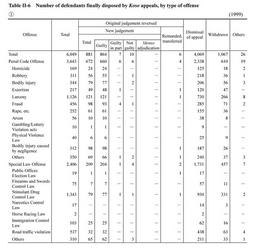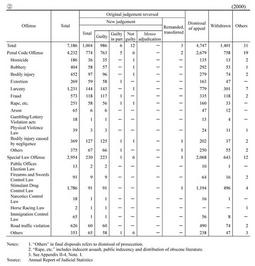| Previous Next Index Image Index Year Selection | |
|
|
3. Appeals The Koso appeal rate against judgments of the first instance handed down in 1999 and 2000 was 10.6% in 1999 and 11.4% in 2000 for district court judgments and5.2% in 1999 and 5.5% in 2000 for summary court judgments. High courts received Koso appeals involving 6,049 defendants in 1999 and 7,186 in 2000. By type of persons concerned in the Koso appeal, 5,905 (97.6%) in 1999 and 7,012 (97.6%) in 2000 were filed on the defendant's part alone, 114 (1.9%) in 1999 and 137 (1.9%) in 2000 were on the public prosecutor's part alone, 29 (0.5%) in 1999 and 35 (0.5%) in 2000 were on both parts, and 1 (0.0%) in 1999 and 2 (0.0%) in 2000 were subject to other dispositions (reversed and remanded or transferred, retried, referred, etc. ) (Source:Annual Report of Judicial Statistics).
Table II-6 shows the judgments made by high courts in Koso appeal trials in 1999 and 2000, by type of offense. In the total number of defendants subject to final disposals by high courts in such trials (6,049 in 1999 and 7,186 in 2000), 67.3% in 1999 and 66.1% in 2000 were subject to dismissal of appeals, 17.6% in 1999 and 19.5% in 2000 to withdrawal of appeals, and 14.6% in 1999 and 14.0% in 2000 to new judgments by high courts. By type of offense, the withdrawal rate was high in the case of Stimulant Drug Control Law violation (24.6%), larceny (23.6%), Physical Violence Law violation (22.5%) and extortion (21.7%), while the new judgment rate (rate of cases in which original judgments were reversed and new judgments were made) was high in the case of bodily injury caused by negligence (31.4%), Immigration Control Law violation (24.3%), rape/indecent assault (24.2%), and bodily injury (23.0%) in 1999. In 2000, the withdrawal rate was high in the case of Physical Violence Law violation (28.2%), Stimulant Drug Control Law violation (27.8%), larceny (24.5%), and gambling/lottery violation acts (22.2%) while the new judgment rate was high in the case of Horse Racing Law violation (50.0%), bodily injury caused by negligence (34.4%), rape/indecent assault (23.1%), and extortion (21.9%). As for the reason for reversal of appeals, 238 (26.8%) in 1999 and 203 (20.2%) in 2000 of the total number of appeals were reversed due to inappropriate sentencing. Under the new judgments, 10 defendants in 1999 and 12 defendants in 2000 were found not guilty as a result of the original judgment being reversed, accounting for 0.2% of the total number of defendants finally disposed by high courts in both years. In the cases in which public prosecutors filed Koso appeals against the not-guilty judgment in the first instance, 12 defendants in 1999 and 21 defendants in 2000 were on Koso appeal trials, and 6 (50.0%) of 12 in 1999 and 18 (85.7%) of 21 in 2000 were found guilty as a result of the original judgment being reversed (Source:Annual Report of Statistics on Prosecution). The Jokoku appeal rate against judgments made by Koso appeal trials in 1999 and 2000 was 40.1% in 1999 and 38.9% in 2000 of the total, higher than the appeal rate against the first instance. The Supreme Court received Jokoku appeals involving 1,720 defendants in 1999 and 1,929 defendants inl 2000, and made final disposal by Jokoku appeal trials on 1,669 defendants in 1999 and 1,938 defendants in 2000. Of these, 424 (25.4%) in 1999 and 558 (28.8%) in 2000 were subject to withdrawal of Jokoku appeals, 1,230 (73.7%) in 1999 and 1,368 (70.6%) in 2000 to dismissal of Jokoku appeals, and 5 (0.3%) in 1999 and 1 (0.1%) in 2000 were reversed and remanded or transferred (Source:Annual Report of Judicial Statistics). Table II-6 Number of defendants finally disposed by Koso appeals, by type of offense |

